Zitong Huang
Dual-Thresholding Heatmaps to Cluster Proposals for Weakly Supervised Object Detection
Sep 10, 2025Abstract:Weakly supervised object detection (WSOD) has attracted significant attention in recent years, as it does not require box-level annotations. State-of-the-art methods generally adopt a multi-module network, which employs WSDDN as the multiple instance detection network module and multiple instance refinement modules to refine performance. However, these approaches suffer from three key limitations. First, existing methods tend to generate pseudo GT boxes that either focus only on discriminative parts, failing to capture the whole object, or cover the entire object but fail to distinguish between adjacent intra-class instances. Second, the foundational WSDDN architecture lacks a crucial background class representation for each proposal and exhibits a large semantic gap between its branches. Third, prior methods discard ignored proposals during optimization, leading to slow convergence. To address these challenges, we first design a heatmap-guided proposal selector (HGPS) algorithm, which utilizes dual thresholds on heatmaps to pre-select proposals, enabling pseudo GT boxes to both capture the full object extent and distinguish between adjacent intra-class instances. We then present a weakly supervised basic detection network (WSBDN), which augments each proposal with a background class representation and uses heatmaps for pre-supervision to bridge the semantic gap between matrices. At last, we introduce a negative certainty supervision loss on ignored proposals to accelerate convergence. Extensive experiments on the challenging PASCAL VOC 2007 and 2012 datasets demonstrate the effectiveness of our framework. We achieve mAP/mCorLoc scores of 58.5%/81.8% on VOC 2007 and 55.6%/80.5% on VOC 2012, performing favorably against the state-of-the-art WSOD methods. Our code is publicly available at https://github.com/gyl2565309278/DTH-CP.
SWAT-NN: Simultaneous Weights and Architecture Training for Neural Networks in a Latent Space
Jun 11, 2025Abstract:Designing neural networks typically relies on manual trial and error or a neural architecture search (NAS) followed by weight training. The former is time-consuming and labor-intensive, while the latter often discretizes architecture search and weight optimization. In this paper, we propose a fundamentally different approach that simultaneously optimizes both the architecture and the weights of a neural network. Our framework first trains a universal multi-scale autoencoder that embeds both architectural and parametric information into a continuous latent space, where functionally similar neural networks are mapped closer together. Given a dataset, we then randomly initialize a point in the embedding space and update it via gradient descent to obtain the optimal neural network, jointly optimizing its structure and weights. The optimization process incorporates sparsity and compactness penalties to promote efficient models. Experiments on synthetic regression tasks demonstrate that our method effectively discovers sparse and compact neural networks with strong performance.
MIRAGE: Assessing Hallucination in Multimodal Reasoning Chains of MLLM
May 30, 2025Abstract:Multimodal hallucination in multimodal large language models (MLLMs) restricts the correctness of MLLMs. However, multimodal hallucinations are multi-sourced and arise from diverse causes. Existing benchmarks fail to adequately distinguish between perception-induced hallucinations and reasoning-induced hallucinations. This failure constitutes a significant issue and hinders the diagnosis of multimodal reasoning failures within MLLMs. To address this, we propose the {\dataset} benchmark, which isolates reasoning hallucinations by constructing questions where input images are correctly perceived by MLLMs yet reasoning errors persist. {\dataset} introduces multi-granular evaluation metrics: accuracy, factuality, and LLMs hallucination score for hallucination quantification. Our analysis reveals that (1) the model scale, data scale, and training stages significantly affect the degree of logical, fabrication, and factual hallucinations; (2) current MLLMs show no effective improvement on spatial hallucinations caused by misinterpreted spatial relationships, indicating their limited visual reasoning capabilities; and (3) question types correlate with distinct hallucination patterns, highlighting targeted challenges and potential mitigation strategies. To address these challenges, we propose {\method}, a method that combines curriculum reinforcement fine-tuning to encourage models to generate logic-consistent reasoning chains by stepwise reducing learning difficulty, and collaborative hint inference to reduce reasoning complexity. {\method} establishes a baseline on {\dataset}, and reduces the logical hallucinations in original base models.
Segmenting Objectiveness and Task-awareness Unknown Region for Autonomous Driving
Apr 27, 2025Abstract:With the emergence of transformer-based architectures and large language models (LLMs), the accuracy of road scene perception has substantially advanced. Nonetheless, current road scene segmentation approaches are predominantly trained on closed-set data, resulting in insufficient detection capabilities for out-of-distribution (OOD) objects. To overcome this limitation, road anomaly detection methods have been proposed. However, existing methods primarily depend on image inpainting and OOD distribution detection techniques, facing two critical issues: (1) inadequate consideration of the objectiveness attributes of anomalous regions, causing incomplete segmentation when anomalous objects share similarities with known classes, and (2) insufficient attention to environmental constraints, leading to the detection of anomalies irrelevant to autonomous driving tasks. In this paper, we propose a novel framework termed Segmenting Objectiveness and Task-Awareness (SOTA) for autonomous driving scenes. Specifically, SOTA enhances the segmentation of objectiveness through a Semantic Fusion Block (SFB) and filters anomalies irrelevant to road navigation tasks using a Scene-understanding Guided Prompt-Context Adaptor (SG-PCA). Extensive empirical evaluations on multiple benchmark datasets, including Fishyscapes Lost and Found, Segment-Me-If-You-Can, and RoadAnomaly, demonstrate that the proposed SOTA consistently improves OOD detection performance across diverse detectors, achieving robust and accurate segmentation outcomes.
MR-GDINO: Efficient Open-World Continual Object Detection
Dec 23, 2024



Abstract:Open-world (OW) recognition and detection models show strong zero- and few-shot adaptation abilities, inspiring their use as initializations in continual learning methods to improve performance. Despite promising results on seen classes, such OW abilities on unseen classes are largely degenerated due to catastrophic forgetting. To tackle this challenge, we propose an open-world continual object detection task, requiring detectors to generalize to old, new, and unseen categories in continual learning scenarios. Based on this task, we present a challenging yet practical OW-COD benchmark to assess detection abilities. The goal is to motivate OW detectors to simultaneously preserve learned classes, adapt to new classes, and maintain open-world capabilities under few-shot adaptations. To mitigate forgetting in unseen categories, we propose MR-GDINO, a strong, efficient and scalable baseline via memory and retrieval mechanisms within a highly scalable memory pool. Experimental results show that existing continual detectors suffer from severe forgetting for both seen and unseen categories. In contrast, MR-GDINO largely mitigates forgetting with only 0.1% activated extra parameters, achieving state-of-the-art performance for old, new, and unseen categories.
Class Balance Matters to Active Class-Incremental Learning
Dec 09, 2024
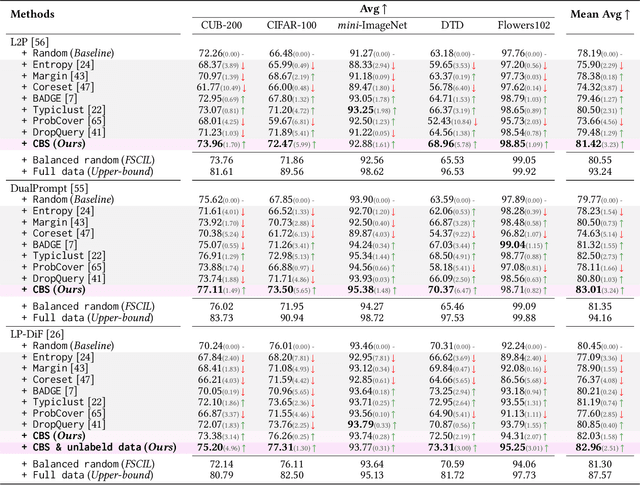

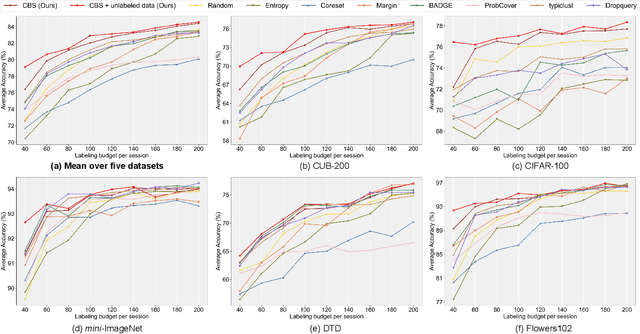
Abstract:Few-Shot Class-Incremental Learning has shown remarkable efficacy in efficient learning new concepts with limited annotations. Nevertheless, the heuristic few-shot annotations may not always cover the most informative samples, which largely restricts the capability of incremental learner. We aim to start from a pool of large-scale unlabeled data and then annotate the most informative samples for incremental learning. Based on this premise, this paper introduces the Active Class-Incremental Learning (ACIL). The objective of ACIL is to select the most informative samples from the unlabeled pool to effectively train an incremental learner, aiming to maximize the performance of the resulting model. Note that vanilla active learning algorithms suffer from class-imbalanced distribution among annotated samples, which restricts the ability of incremental learning. To achieve both class balance and informativeness in chosen samples, we propose Class-Balanced Selection (CBS) strategy. Specifically, we first cluster the features of all unlabeled images into multiple groups. Then for each cluster, we employ greedy selection strategy to ensure that the Gaussian distribution of the sampled features closely matches the Gaussian distribution of all unlabeled features within the cluster. Our CBS can be plugged and played into those CIL methods which are based on pretrained models with prompts tunning technique. Extensive experiments under ACIL protocol across five diverse datasets demonstrate that CBS outperforms both random selection and other SOTA active learning approaches. Code is publicly available at https://github.com/1170300714/CBS.
InfiniteWorld: A Unified Scalable Simulation Framework for General Visual-Language Robot Interaction
Dec 08, 2024Abstract:Realizing scaling laws in embodied AI has become a focus. However, previous work has been scattered across diverse simulation platforms, with assets and models lacking unified interfaces, which has led to inefficiencies in research. To address this, we introduce InfiniteWorld, a unified and scalable simulator for general vision-language robot interaction built on Nvidia Isaac Sim. InfiniteWorld encompasses a comprehensive set of physics asset construction methods and generalized free robot interaction benchmarks. Specifically, we first built a unified and scalable simulation framework for embodied learning that integrates a series of improvements in generation-driven 3D asset construction, Real2Sim, automated annotation framework, and unified 3D asset processing. This framework provides a unified and scalable platform for robot interaction and learning. In addition, to simulate realistic robot interaction, we build four new general benchmarks, including scene graph collaborative exploration and open-world social mobile manipulation. The former is often overlooked as an important task for robots to explore the environment and build scene knowledge, while the latter simulates robot interaction tasks with different levels of knowledge agents based on the former. They can more comprehensively evaluate the embodied agent's capabilities in environmental understanding, task planning and execution, and intelligent interaction. We hope that this work can provide the community with a systematic asset interface, alleviate the dilemma of the lack of high-quality assets, and provide a more comprehensive evaluation of robot interactions.
Simultaneous Weight and Architecture Optimization for Neural Networks
Oct 10, 2024



Abstract:Neural networks are trained by choosing an architecture and training the parameters. The choice of architecture is often by trial and error or with Neural Architecture Search (NAS) methods. While NAS provides some automation, it often relies on discrete steps that optimize the architecture and then train the parameters. We introduce a novel neural network training framework that fundamentally transforms the process by learning architecture and parameters simultaneously with gradient descent. With the appropriate setting of the loss function, it can discover sparse and compact neural networks for given datasets. Central to our approach is a multi-scale encoder-decoder, in which the encoder embeds pairs of neural networks with similar functionalities close to each other (irrespective of their architectures and weights). To train a neural network with a given dataset, we randomly sample a neural network embedding in the embedding space and then perform gradient descent using our custom loss function, which incorporates a sparsity penalty to encourage compactness. The decoder generates a neural network corresponding to the embedding. Experiments demonstrate that our framework can discover sparse and compact neural networks maintaining a high performance.
CPT: Consistent Proxy Tuning for Black-box Optimization
Jul 01, 2024

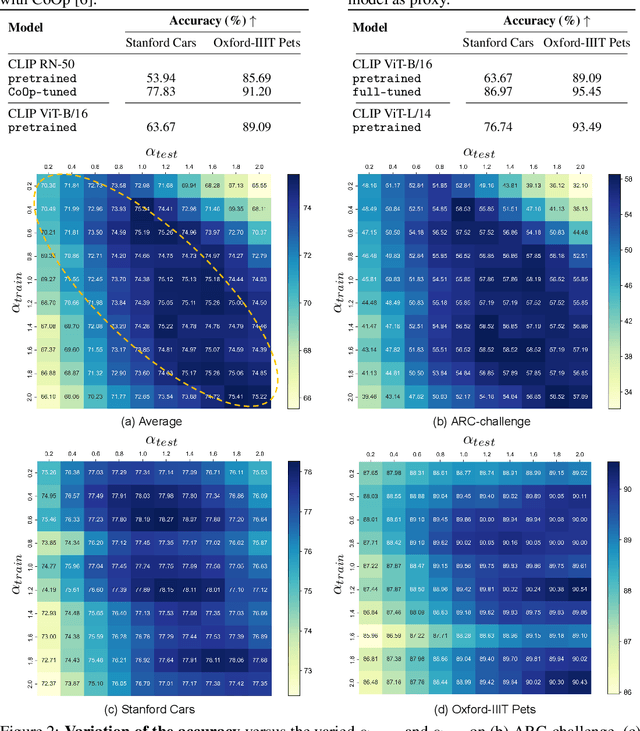
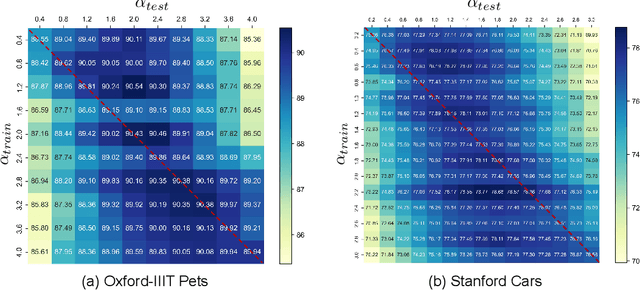
Abstract:Black-box tuning has attracted recent attention due to that the structure or inner parameters of advanced proprietary models are not accessible. Proxy-tuning provides a test-time output adjustment for tuning black-box language models. It applies the difference of the output logits before and after tuning a smaller white-box "proxy" model to improve the black-box model. However, this technique serves only as a decoding-time algorithm, leading to an inconsistency between training and testing which potentially limits overall performance. To address this problem, we introduce Consistent Proxy Tuning (CPT), a simple yet effective black-box tuning method. Different from Proxy-tuning, CPT additionally exploits the frozen large black-box model and another frozen small white-box model, ensuring consistency between training-stage optimization objective and test-time proxies. This consistency benefits Proxy-tuning and enhances model performance. Note that our method focuses solely on logit-level computation, which makes it model-agnostic and applicable to any task involving logit classification. Extensive experimental results demonstrate the superiority of our CPT in both black-box tuning of Large Language Models (LLMs) and Vision-Language Models (VLMs) across various datasets. The code is available at https://github.com/chunmeifeng/CPT.
LayerMatch: Do Pseudo-labels Benefit All Layers?
Jun 20, 2024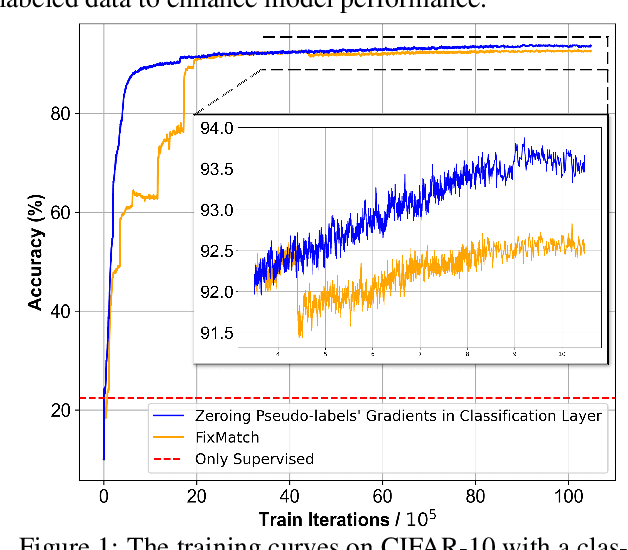
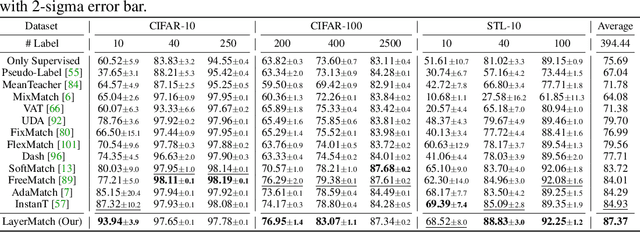
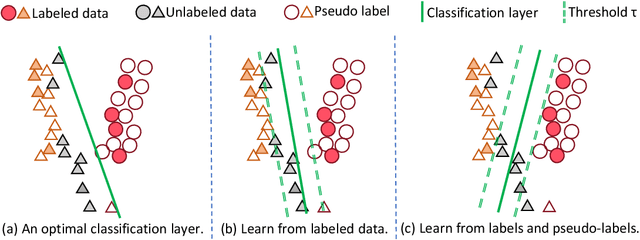

Abstract:Deep neural networks have achieved remarkable performance across various tasks when supplied with large-scale labeled data. However, the collection of labeled data can be time-consuming and labor-intensive. Semi-supervised learning (SSL), particularly through pseudo-labeling algorithms that iteratively assign pseudo-labels for self-training, offers a promising solution to mitigate the dependency of labeled data. Previous research generally applies a uniform pseudo-labeling strategy across all model layers, assuming that pseudo-labels exert uniform influence throughout. Contrasting this, our theoretical analysis and empirical experiment demonstrate feature extraction layer and linear classification layer have distinct learning behaviors in response to pseudo-labels. Based on these insights, we develop two layer-specific pseudo-label strategies, termed Grad-ReLU and Avg-Clustering. Grad-ReLU mitigates the impact of noisy pseudo-labels by removing the gradient detrimental effects of pseudo-labels in the linear classification layer. Avg-Clustering accelerates the convergence of feature extraction layer towards stable clustering centers by integrating consistent outputs. Our approach, LayerMatch, which integrates these two strategies, can avoid the severe interference of noisy pseudo-labels in the linear classification layer while accelerating the clustering capability of the feature extraction layer. Through extensive experimentation, our approach consistently demonstrates exceptional performance on standard semi-supervised learning benchmarks, achieving a significant improvement of 10.38% over baseline method and a 2.44% increase compared to state-of-the-art methods.
 Add to Chrome
Add to Chrome Add to Firefox
Add to Firefox Add to Edge
Add to Edge